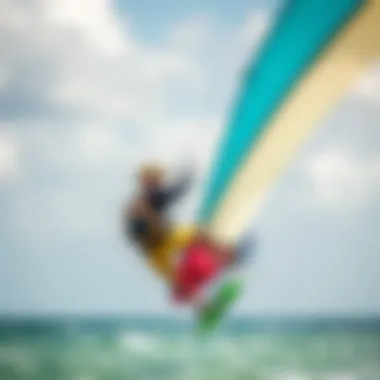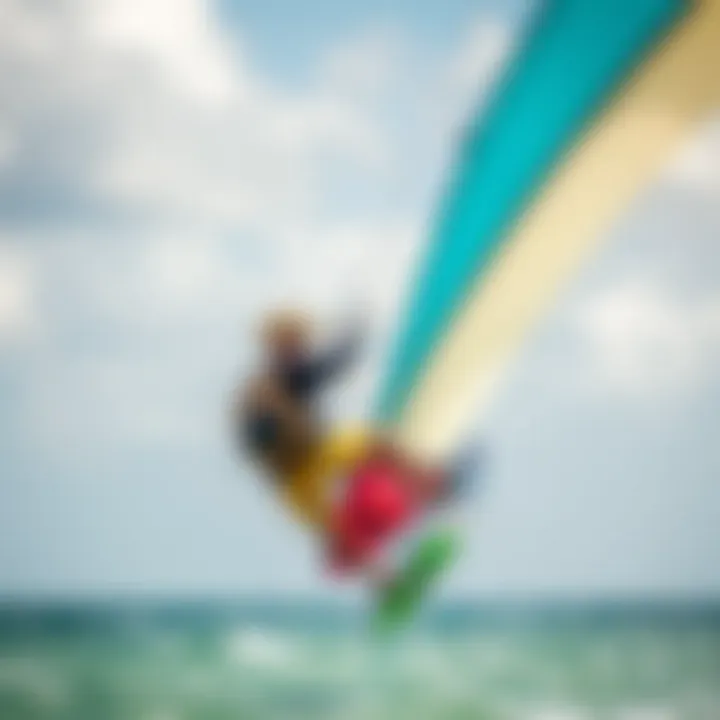Understanding Kiteboard Kite Size Charts for Optimal Performance


Intro
Kiteboarding is more than just a thrilling sport; it’s a blend of art and science that requires understanding the nuances of equipment. The kites you choose can mean the difference between soaring effortlessly above waves or struggling against the wind. This is where kite size charts become essential. Whether you’re a newbie feeling the bite of the sea breeze or a seasoned rider looking to refine your game, knowing your way around kite sizes can greatly enhance your experience on the water.
Choosing the right kite depends on numerous factors. These include your weight, the current wind conditions, and your riding skill. The interplay of these elements can dictate not just your comfort but also your performance. Missteps in selection can lead to frustrating outings or even dangerous situations. Therefore, it’s crucial to grasp the significance of different sizes and how they correlate to your unique riding style.
This guide will dissect these vital aspects, helping you navigate kite size charts like a pro. Let’s kick things off by diving into gear selection.
Prelims to Kiteboarding
Kiteboarding, often thought of as a blend of surfing and paragliding, is more than just a pastime; it's a thrilling dance with the wind and water. An understanding of this sport revolves around its exhilarating nature and the technical nuances that dictate rider success. Here, we delve into the heart of kiteboarding, dissecting the essential components of the sport with a focus on equipment, particularly kite size. The right gear can be the difference between soaring through the waves and struggling against the elements. Let’s embark on this journey to uncover the fundamentals that make kiteboarding more than just a sport—it’s an experience.
Overview of the Sport
Kiteboarding, while it may sound like a buzzword to novice enthusiasts, has roots that date back quite a while. It combines the thrill of surfing with the freedom of kites. When the wind hits your kite just right, it feels like you’re gliding, harnessing the very power of nature. Riders use a specially designed board, attached to a large inflatable kite, which, when maneuvered skillfully, gives the rider the ability to leap over the waves or cruise along the coastline.
The sport has grown exponentially in popularity, not just for the adrenaline it provides but also for the sense of community that accompanies it. Whether it’s sharing tips with fellow riders or gathering for competitions, kiteboarders are part of a vibrant, welcoming ecosystem. You see, it’s not just about individual pursuits; it's about creating bonds while riding the winds—and believe me, a perfect day on the water with friends creates memories that last a lifetime.
Importance of Equipment Choice
In anything we take on, let’s face it, the right tools can make a world of difference, and kiteboarding is no exception. When discussing kiteboarding, equipment choice, especially kite size, ranks high on the list. A well-chosen kite can enhance a rider's control and comfort, providing a more enjoyable experience. Conversely, selecting a kite that’s too big or too small can lead to frustration and, at worst, danger.
Now, some may think, "Bigger must be better," but that simply isn't the case here. The size of the kite directly relates to a number of aspects, including rider weight and skill level, the wind conditions, and personal preferences. You wouldn’t use a sledgehammer for precision work, right? Likewise, a kite that's ill-fitted for the rider's specifications can hinder performance and take the fun out of kiteboarding.
To sum it up, understanding and selecting the right kite is fundamental for maximizing not just performance but also safety. So before rushing to the beach, make sure you know your stuff—because down that sandy shore lies not just a sport, but a zesty community ready to welcome you into a world filled with excitement.
Understanding Kite Size
Kite size is more than just a number on a chart; it’s a fundamental aspect of kiteboarding that can significantly impact your experience. Whether you're a seasoned rider looking to optimize your performance or a newcomer hoping to navigate the winds, understanding kite size is essential. The right kite size ensures that you maintain control and harness the wind's power effectively. Factors like rider weight, wind speeds, and skill levels all come into play when selecting a kite size.
Choosing the correct kite size can mean the difference between gliding smoothly across the water or struggling to stay airborne. By having a firm grasp of kite sizes, enthusiasts can equate their personal riding style with appropriate kite selection, enhancing not just performance but also safety during rides.
Each aspect of kite size comes with its own set of specific elements to consider:
- Increased Maneuverability: A smaller kite can be quicker to turn, which is ideal for tricks and jumps.
- Wind Range Considerations: Larger kites can catch more wind but can also become harder to control in high winds.
- Rider Experience: Beginner kiteboarders may find comfort with larger kites in lighter winds, while more experienced ones might prefer smaller kites for dynamic rides.
Having a clear understanding of kite sizes can also clear up any confusion about charts and recommendations that might initially feel overwhelming. Let's take a deeper look into kite size specifics.
What is Kite Size and Why It Matters
Kite size refers to the surface area and overall dimensions of the kite, typically measured in square meters. But why should this matter to you? First off, kite size significantly influences how well you can ride, control, and enjoy your time on the water.
- Surface Area Impact: A kite with a larger surface area will generate more lift, providing you with better support when you’re gusting. This can be especially beneficial for beginners who might need that extra help in staying airborne.
- Control Under Conditions: Understanding how your kite’s dimensions interact with wind speed can assist you in choosing the right size. Different wind conditions truly dictate whether you should opt for a smaller or larger kite.
In essence, selecting the right kite size doesn't just affect your performance; it affects your enjoyment of the sport itself.


Different Types of Kites and Their Sizes
When it comes to kiteboarding, not all kites are created equal, and they come in various shapes and sizes designed for different conditions and riding styles. Here’s a breakdown of common types of kites you might encounter:
- C-Kites: Known for their traditional design, they have a "C" shape and are favored by freestyle riders due to their exceptional performance for jumps and tricks. Sizes typically range from 7 to 14 meters.
- Bow Kites: These kites are flatter and have a larger surface area, allowing for easy relaunch and increased depower. Sizes often range from 9 to 17 meters.
- Delta Kites: Resembling a triangle, delta kites are versatile and perform well in a variety of wind conditions. They usually come in sizes from 5 to 15 meters.
- Foil Kites: Ideal for low wind conditions, foil kites are made from fabric and have no internal framework. They can be designed for both land and water use, generally ranging from 4 to 10 meters.
As each kite type fits specific conditions, knowing your individual requirements and riding style can help you choose the right kite size. The interaction between the kite type and size is crucial to ensuring your kiteboarding sessions are enjoyable and safe.
The Kite Size Chart: A Detailed Look
Understanding the intricacies of kite size charts can greatly enhance your kiteboarding experience. These charts are crucial as they summarize essential parameters that help riders select the appropriate kite sizes for diverse conditions. Knowing how to interpret these charts allows you to make informed decisions that can impact your performance on the water.
A key benefit of kite size charts is their ability to provide a one-stop reference point. They condense complex choices into clear metrics based around rider weight and wind conditions. This simplification enables both novice and experienced kiteboarders to choose the best kite size without pinpointing the plethora of factors at play. Moreover, having a kite that aligns with your size chart recommendations increases safety— a critical aspect of the sport, as mismatched equipment can lead to accidents.
While the kite size chart is a comprehensive guide, it’s imperative to recognize that it isn’t set in stone. Individual needs may vary based on riding styles and skill levels. Therefore, while these charts serve as a useful snapshot, they should be used alongside personal experience and environmental conditions to ensure the best fit for your unique situation.
Components of a Kite Size Chart
A kite size chart comprises several key elements that contribute to its usefulness:
- Kite Size (in square meters): This is the primary measurement that indicates the surface area of the kite.
- Rider Weight: Many charts will list recommended kite sizes based on various weight ranges.
- Wind Speed Ranges (in knots): Understanding the appropriate kite size for certain wind speeds can make a huge difference in performance.
Also included may be metrics about skill level, which helps to tailor the choice for beginners versus advanced riders. Each of these components combines to provide a clear picture of which kite to choose, depending on your specific situation as a rider.
How to Read Kite Size Charts
Reading kite size charts requires a bit of practice, but it’s not rocket science. To get started, follow these basic steps:
- Locate Your Weight: Start by finding your weight on the chart. This will typically be laid out in ascending order.
- Identify Wind Conditions: Next, match your weight with the corresponding wind conditions. Charts may display this in knot ranges like light, medium, and strong winds.
- Select Kite Size: Upon intersection, you’ll identify recommended kite sizes for the given weight and wind speed.
- Consider Experience: If you’re a beginner, it might be wise to lean toward the larger kite size within the recommended range, as this can help with lift and stability, particularly in lighter winds.
Understanding how to properly read kite size charts can not only elevate your enjoyment of the sport but also enhance your safety on the water.
In addition, one must remember that external factors could influence the selection, such as specific regional wind characteristics or personal skill enhancement. Experience will greatly assist as you begin to match your abilities with the numbers on the chart. Therefore, using kite size charts is an essential first step on your journey to mastering kiteboarding.
Factors Influencing Kite Size Selection
Choosing the right kite size is like selecting the perfect ingredient for a dish; it can make or break the experience on the water. Several factors come into play when making this decision, as they can significantly influence performance, safety, and enjoyment. Let's delve into the elements crucial for picking the right kite size.
Rider Weight and Skill Level
When it comes to kiteboarding, the rider's weight is a major player in the kite size equation. Generally, heavier riders require larger kites to generate sufficient lift, while lighter riders can get away with smaller sizes. For instance, if you weigh around 160 pounds, a kite size ranging from 9 to 13 meters might work well under different wind conditions. On the other hand, if you’re tipping the scales at 220 pounds, a size somewhere between 12 to 16 meters could be in the ballpark.
It is not just about weight; skill level plays a huge role too. Novice riders might struggle with larger kites, which can have a tendency to pull heavily and become hard to manage. Experienced kiteboarders, however, can handle bigger kites and exploit their strength for high jumps and powerful rides. If you are just starting, it might be wise to stick to a medium-sized kite that complements your skill level, providing you better control without overwhelming you.
Wind Conditions and Environments
Wind conditions can shift like the sands of time, and understanding them is vital for kite size selection. The speed and consistency of the wind affect how a kite performs. For instance, choppy, gusty wind often requires a smaller kite to maintain better control. If you're out on a day where the wind is between 15 to 20 knots, a 10-meter kite might be just the ticket. However, on a lighter wind day of 8 to 12 knots, you might need to upsize to around 12 meters or more to sustain lift and glide.


Moreover, the environment where you’re kiting plays a significant role as well. Coastal locations with consistent winds typically allow for the use of larger kites, while inland lakes with unpredictable breezes might require smaller sizes to help reduce the risk of being pulled too forcefully by unexpected gusts.
Key Point: Always check the local weather forecasts and consider the specific conditions of the water body you are heading to.
In terms of preparation, take time to gather insights from local riders or schools, as they often have real-time knowledge about wind patterns that can greatly assist you.
Balancing rider weight, skill level, and wind conditions can mean the difference between soaring through the waves with confidence or getting pulled unceremoniously into the drink. Armed with this foundational understanding, you can step into kiteboarding adventures with gusto.
Common Misconceptions Regarding Kite Size
The topic of common misconceptions regarding kite size is crucial in understanding kiteboarding. Misunderstandings can lead to poor choices, affecting not only rider performance but also safety on the water. Kite size is not merely a number; it symbolizes a balance between rider, wind conditions, and the kite itself. Each element plays a role in optimizing your experience. Thus, addressing these misconceptions helps enthusiast and instructors to make informed and confident decisions while selecting equipment.
Debunking Popular Myths
When it comes to kite size, several myths float around like an errant kite in a gusty wind. Here are a few that need to be set straight:
- Bigger is Always Better: Many riders believe larger kites will guarantee higher performance. However, overestimating your kite size can lead to difficulties in control and increased risk during high winds.
- Size Doesn't Change with Weight: It's a common thought that kite sizes are standardized, but a rider's weight plays a large role. Heavier riders often need larger kites than lightweight riders to achieve the same power and lift.
- More Experienced Riders Use Small Kites Only: Some think that only seasoned riders should use smaller kites. While experienced riders may prefer smaller kites for maneuverability, it ultimately depends on wind conditions and personal riding style.
Understanding these misconceptions can save riders from poor decisions. It's essential to question assumptions and consider your unique circumstances.
The Impact of Experience on Kite Selection
Experience levels markedly affect how kite size is decided. A newcomer might think that simply following a size chart is enough, but it's not that straightforward. Learning the ropes often involves trial and error.
For beginners, starting with a medium-sized kite offers a balance of power and control. They can gradually work their way up or down based on their comfort. As for someone who's been hitting the waves for a while, they might navigate between various kite sizes based on conditions and personal comfort.
Moreover, experience goes hand-in-hand with understanding environmental factors. A well-practiced rider is likely to gauge conditions like wind direction and speed more effectively. This knowledge allows them to choose a kite that aligns closely with their skills and the day's challenges.
In summary, acknowledging the impact of experience on kite selection fosters better understanding. This knowledge can lead to safer and more enjoyable kiteboarding experiences.
The Relationship Between Kite Size and Performance
Understanding the link between kite size and performance is crucial for anyone involved in kiteboarding. A kite's size isn't just a number on a chart; it fundamentally influences how you feel on the water. The right size can dramatically enhance your control, while the wrong one can leave you fighting against the wind, rather than riding it.
When we discuss performance, several layers come into play. First, kite size dictates how much power you can harness from the wind. Smaller kites tend to be faster and more reactive, which can benefit experienced riders who enjoy making intricate maneuvers. On the flip side, larger kites provide a greater pull, making them suitable for lighter winds and enabling novice riders to gain some confidence without battling too much against the elements.
Other aspects, like rider weight and skill level, further complicate the relationship. For instance, a heavier rider might need a larger kite to catch the same amount of wind as a lighter rider. Conversely, an advanced rider may opt for a smaller kite to enjoy quicker turns and better handling, even in moderate wind conditions.
"Choosing the right kite size can mean the difference between a smooth glide and a turbulent ride."
Thus, understanding your own preferences and riding style is pivotal. This relationship between kite size and performance is central to achieving a balance between power and control, ultimately enhancing overall enjoyment on the water.
How Kite Size Affects Control
The size of the kite plays a vital role in how well you can control it. When you’re out there in the waves, a larger kite may feel a bit cumbersome, particularly during swift turns or when navigating through choppy waters. The greater surface area of a big kite can catch more wind, which, although advantageous in low wind conditions, can lead to instability for some riders. If it’s going to feel like you're steering a bus instead of a nimble sports car, it’s time to rethink your gear.
On the contrary, a smaller kite offers a heightened sense of control. You’ll find yourself able to make faster adjustments, allowing for rapid acceleration and deceleration. This responsiveness can make all the difference, particularly in competitive scenarios or when performing tricks. However, too small a kite could lead you to struggle in underpowered conditions, where it might not have enough pull to get you up and moving.


To sum it up, achieving the desired control starts with understanding the specific wind conditions and your riding style. A kite that's too big for your skill set will leave you grappling with its power, while a kite too small may leave you vulnerable when you need that additional lift.
The Link Between Size and Maneuverability
When discussing maneuverability, kite size again proves to be a fundamental factor in how effectively a rider can navigate the water. Smaller kites generally provide enhanced maneuverability. They allow you to whip around corners and navigate tricky spots with greater agility. Riders who prefer freestyle tricks or rapid movements in the water often find themselves reaching for smaller kites.
However, this agile nature comes with trade-offs. While smaller kites shine in quick turns, they might not deliver the same power and lift as larger kites when you're trying to get airborne. This is particularly relevant for jumpers who need a significant amount of pull to gain altitude. So aiming for the type of performance you’re after is key when selecting kite sizes for specific maneuvers.
In essence, there’s a balancing act: one must assess the particular scenarios they face and match their kite accordingly. Know that whether you opt for large or small, each kite size comes with its own set of benefits and limitations in maneuverability, guiding your adventure on the water. The expertise to harness this knowledge will undoubtedly elevate your kiteboarding experience.
Best Practices for Selecting Kite Size
Choosing the right kite size is pivotal in kiteboarding. A well-suited kite can turn an average day into an exhilarating experience, while the wrong choice might leave you feeling overpowered or underwhelmed. As the saying goes, "It's not the arrow, it's the Indian," meaning that the equipment is crucial, but so are the skills and understanding behind its use. This section lays out best practices to ensure you select a kite that complements your style and needs.
Assessing Your Riding Style
Your riding style plays a significant role in determining which kite size best suits you. Each rider is unique, with different preferences when it comes to speed, power, and maneuverability. Some might prefer the thrill of high jumps and tricks, while others lean towards cruising and enjoying the scenery.
- Freestyle: If you're into performing tricks, you'll benefit from a smaller kite that provides quick response and easier maneuverability. A smaller size enables you to gain more control while executing aerial moves.
- Wave Riding: A larger kite might be advantageous here, especially in light winds, allowing for more lift and stability. In this case, it's important to ensure the kite can handle surf conditions without overpowering you.
- All-Around Riding: For riders who enjoy various styles, a medium-sized kite can strike a balance between power and control, making it versatile enough for different conditions.
When assessing your riding style, think about the conditions you typically encounter. Do you often ride in winds that are light or strong? Are you targeting flat water or waves? This consideration will help you narrow down the appropriate kite size.
Consulting with Experienced Riders
Never underestimate the value of chatting with seasoned kiteboarders. They often possess a wealth of knowledge that can guide you through the process of choosing the right kite size. Engaging with more experienced individuals serves two primary purposes:
- Personal Recommendations: They can share what worked for them based on their experience, steering you clear from potential pitfalls. If they mention a specific brand or size that didn't suit them in particular wind conditions, that's information worth noting.
- Local Insights: Conditions can greatly vary by location. A rider familiar with your typical kiting spot can provide insights on how kite sizes perform there. Sometimes, a kite that works perfectly in one area can be a nightmare elsewhere.
Consider visiting local kiteboarding forums like the one found at reddit.com/r/kiteboarding to read about others' experiences or ask questions. Connect with local kiteboarding schools or clubs; instructors often have a good grasp on equipment, helping novices in making informed choices.
"A good kiteboarder learns from his own mistakes, a great one learns from the mistakes of others."
In summary, selecting the right kite size is not just about picking a number; it encompasses a range of factors including your personal style and feedback from the kiteboarding community. Taking the time to assess your riding style and consulting with those who have been through the ropes can make all the difference, paving the way for a safer and more enjoyable kiteboarding experience.
Closure: Making Informed Decisions
When it comes to kiteboarding, the choices you make in selecting the appropriate kite size can significantly influence not only your enjoyment but also your safety. This article has delved into the various aspects of kite size charts and what they mean for your performance on the water. Making informed decisions about kite sizes is not just a matter of preference; it is about understanding the variables that contribute to your riding experience.
To conclude, understanding how to interpret a kite size chart properly and the factors that influence kite selection is paramount. From rider weight to skill level and wind conditions, each element plays a crucial role in determining the ideal kite size. Recognizing these factors and learning to assess them effectively can greatly enhance your kiteboarding journey, transforming it from merely a hobby into a rewarding adventure.
Summary of Key Takeaways
In this article, several key points have been highlighted to guide your kite size selection:
- Know the Basics: Always start with a clear understanding of kite size and how it correlates with rider attributes such as weight and skill.
- Refer to Size Charts: Familiarize yourself with size charts specific to different kite types; they are your roadmap in this complex landscape.
- Assess Your Environment: Wind conditions change, so be prepared to adjust your kite size choice based on these fluctuations.
- Avoid Common Myths: Understanding what size kite works for you is often shrouded in misconceptions; clear your mind of these errors for better decision-making.
- Emphasize Learning: Kiteboarding is a sport where continuous learning pays off in enjoymment and safety; take time to gather more knowledge about equipment.
The Importance of Continuous Learning
Kiteboarding is not static; it evolves, and so should your understanding of the sport. Continuous learning ensures that you stay safe and competent on the water. Engaging with the kiteboarding community, attending workshops, and experimenting with different kites can expand your perspective.
Consider diving deeper into online resources or local clubs where you can discuss kite size selection with seasoned riders. Sites like reddit.com/r/Kiteboarding or even social media groups can be excellent platforms for this purpose.
By making informed decisions through education and experience, you not only enhance your own skills but also contribute to the broader kiteboarding community. Remember, the ocean is both a playground and a realm of challenges; approach it wisely and you'll be reaping the rewards for many seasons to come.















